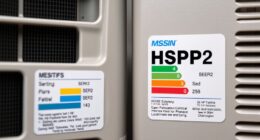To size a surge tank that stops splash-out and prevents your system from emptying, you need to analyze pressure fluctuations and fluid volume changes during operation. Calculate the peak flow rates, pressure surges, and potential volume shifts, then select a tank capacity that provides enough buffer space to absorb these variations. Proper placement and safety margins ensure reliable performance. Keep in mind, understanding these factors helps you choose the right size—so continue exploring for detailed guidance.
Key Takeaways
- Calculate the maximum expected fluid volume change to determine minimum surge tank capacity preventing overflow during system empties.
- Incorporate safety margins in tank size to account for unexpected surges and system variability.
- Position the surge tank close to high-flow or high-pressure points to quickly absorb pressure fluctuations.
- Use overflow outlets sized for maximum volume to safely vent excess fluid and prevent splash-out.
- Regularly monitor system pressure and volume data to adjust surge tank size and prevent emptying-related splash-out events.
Understanding the Role of Surge Tanks in Fluid Systems
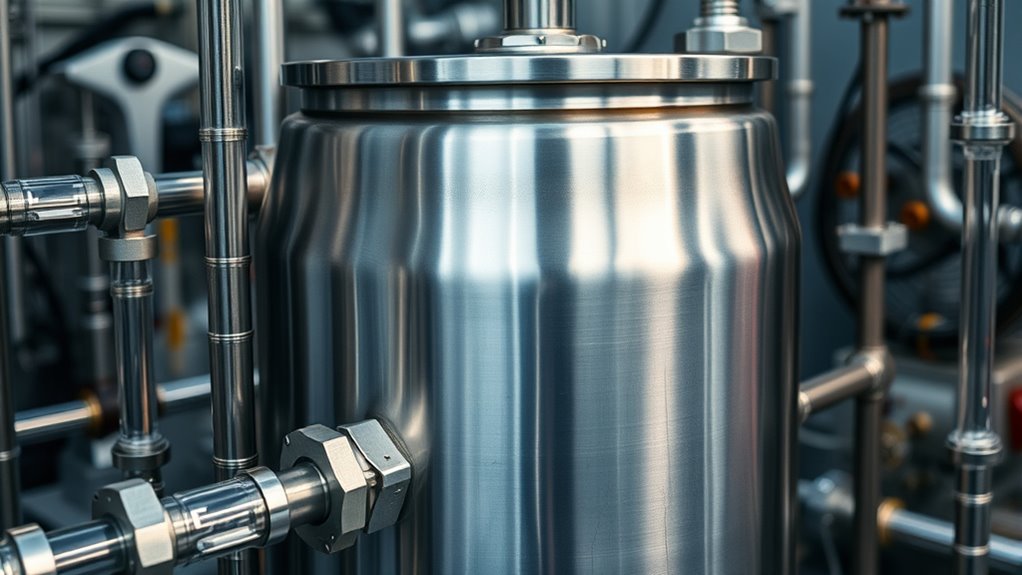
Ever wondered why surge tanks are essential in fluid systems? They act as buffers to manage pressure changes caused by sudden flow variations. When fluid flow speeds up or slows down unexpectedly, pressure fluctuations can occur, risking damage to pipes, pumps, and other components. Surge tanks absorb these shocks, maintaining a steady pressure and preventing system failures. They also help control water hammer effects, which can cause loud noises and physical stress. By providing a space for excess fluid to flow into, surge tanks stabilize the system and protect equipment. Properly designed surge tanks take into account regional variations in system operation and local conditions to ensure optimal performance. Without them, pressure surges could lead to costly repairs, downtime, and even safety hazards. Understanding their role guarantees you can design fluid systems that are both reliable and efficient.
Determining System Pressure Fluctuations and Surges
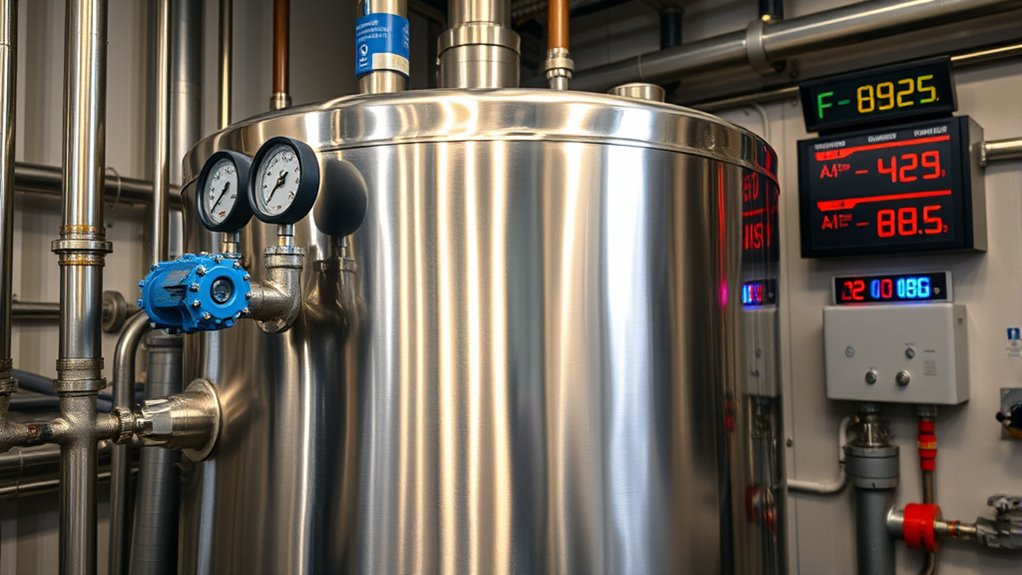
To effectively determine system pressure fluctuations and surges, you need to analyze flow conditions and the system’s response to transient events. Start by monitoring pressure at critical points during normal operation and sudden changes, such as valve closures or pump startups. Use data loggers or pressure transducers for real-time readings to identify spike magnitudes and durations. Pay close attention to how quickly pressure rises and falls, indicating the system’s sensitivity to disturbances. Note any irregular patterns or persistent surges that could cause damage or inefficiency. Understanding these fluctuations helps you recognize the maximum pressure variations your system experiences. This insight is essential for designing a surge tank that can absorb pressure spikes without causing splash-out or system failure. Additionally, evaluating Bitcoin volatility can aid in planning for unexpected fluctuations that impact system stability.
Calculating Fluid Volume Changes During Operation
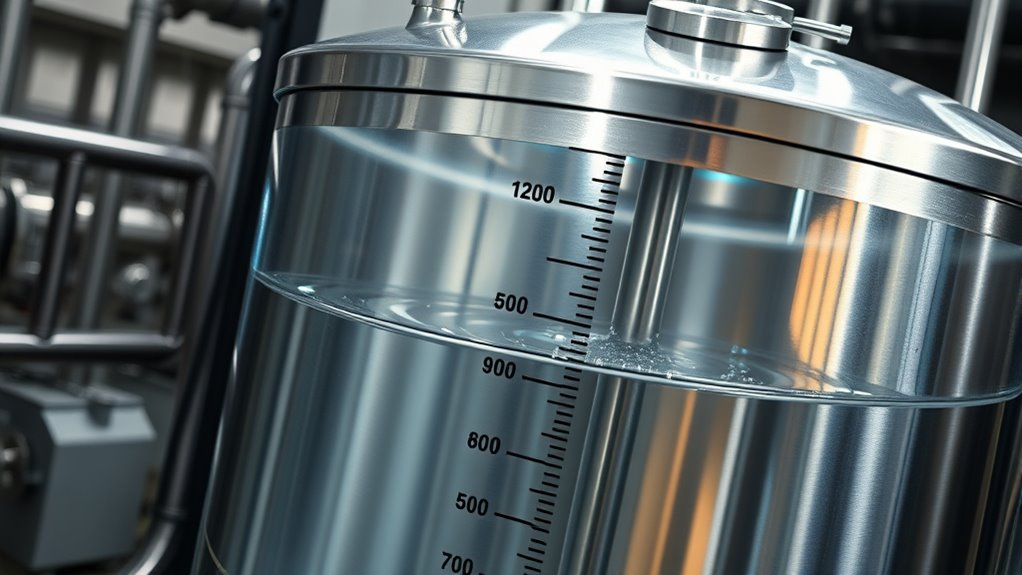
Understanding how fluid volume changes during operation is essential for designing an effective surge tank. You need to anticipate fluctuations caused by system activity, temperature shifts, and pressure variations. These changes impact your surge tank’s size and shape, ensuring it can accommodate volume shifts without overflowing or running dry. To calculate these changes, consider factors like flow rates, system cycle times, and fluid compressibility. Incorporating community challenges can provide practical insights into real-world system behaviors. Use real system data for accurate volume change estimations. Accurate calculations help you size the surge tank precisely, preventing splash-out and system failures.
Selecting Appropriate Surge Tank Capacity
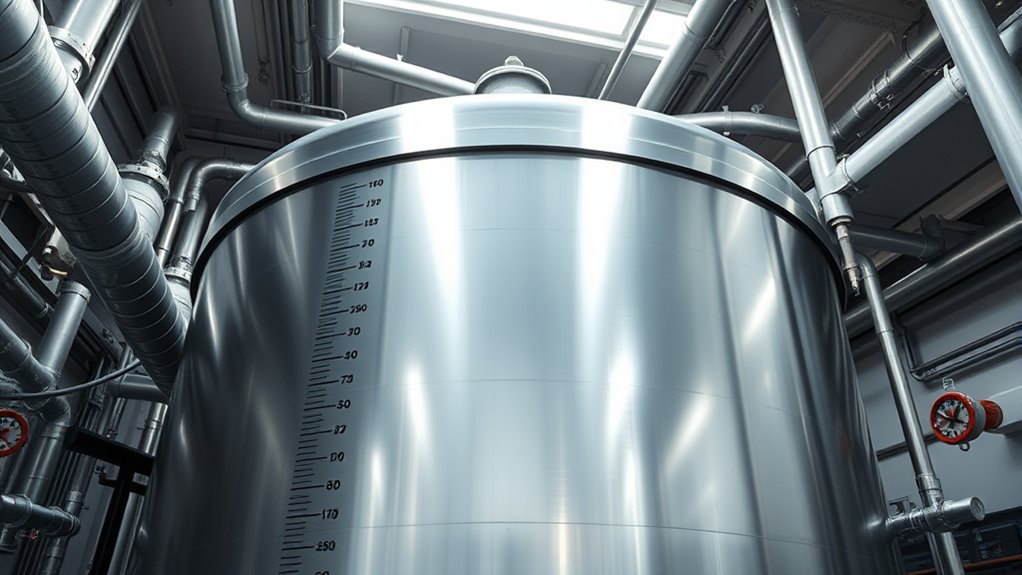
To choose the right surge tank capacity, you need to assess your system’s variability needs and how much buffer is required for peak flow rates. This helps prevent overflow and guarantees smooth operation during sudden changes. Understanding industry trends and getting this balance right keeps your system safe and efficient.
Calculating System Variability Needs
Calculating the system variability needs is essential for selecting the right surge tank capacity. You need to comprehend how flow rates fluctuate during normal operation and transient events. This helps ensure your tank can handle sudden changes without overflowing or running dry. To do this effectively, consider:
- Peak flow rates during system surges
- Normal operating flow variations
- System response times to flow changes
- The frequency of transient events
- Minimum flow requirements during low-demand periods
- Bedroom design principles can also inform the placement and layout of surge tanks to optimize space and accessibility.
Buffering Peak Flow Rates
Selecting the appropriate surge tank capacity involves ensuring it can effectively buffer peak flow rates during sudden system surges. You need a tank that absorbs rapid changes without overflowing or emptying too quickly. To determine this, consider the maximum flow rate your system might experience and the volume needed to cushion those peaks. A well-sized tank prevents system stress and maintains stability. The selection process should also account for life support, ensuring the system remains reliable under all operating conditions. Use the table below to relate flow rate to tank volume, helping you choose an appropriate capacity:
| Peak Flow Rate (L/min) | Required Surge Tank Volume (L) |
|---|---|
| 50 | 25 |
| 100 | 50 |
| 150 | 75 |
| 200 | 100 |
| 250 | 125 |
Preventing Excessive Overflow
Ensuring your surge tank doesn’t overflow is crucial for system safety and reliability. An oversized tank wastes space and costs more, while an undersized one risks overflows and system damage. To select the right capacity, consider these factors:
- Peak flow rate and expected fluctuations
- System operating pressure and pressure surges
- Inflow and outflow rates during normal and abnormal conditions
- Space limitations and physical constraints
- Safety margins to accommodate unexpected surges
- Understanding how arcade games work can inform maintenance and troubleshooting practices for system components.
Considering System Dynamics and Flow Rates

Understanding system dynamics and flow rates is essential for accurately sizing a surge tank. You need to analyze how fluid moves through your system, including how quickly flow rates change during startup, shutdown, or sudden demand shifts. Rapid flow variations can cause pressure surges or drop-offs, so your tank must accommodate these fluctuations without risking splash-out or cavitation. Measure peak flow rates and consider how long it takes for flow to stabilize after disturbances. By understanding these patterns, you can determine the appropriate volume and response capacity of your surge tank. This ensures it effectively dampens pressure spikes, maintains system stability, and prevents splash-out, especially during transient conditions. Accurate flow rate assessment is key to designing a reliable, efficient surge containment solution. Additionally, considering cake pops as an analogy can help visualize how sudden changes in flow or pressure need to be absorbed smoothly to prevent system failure.
Incorporating Buffer Space to Prevent Splash-Out
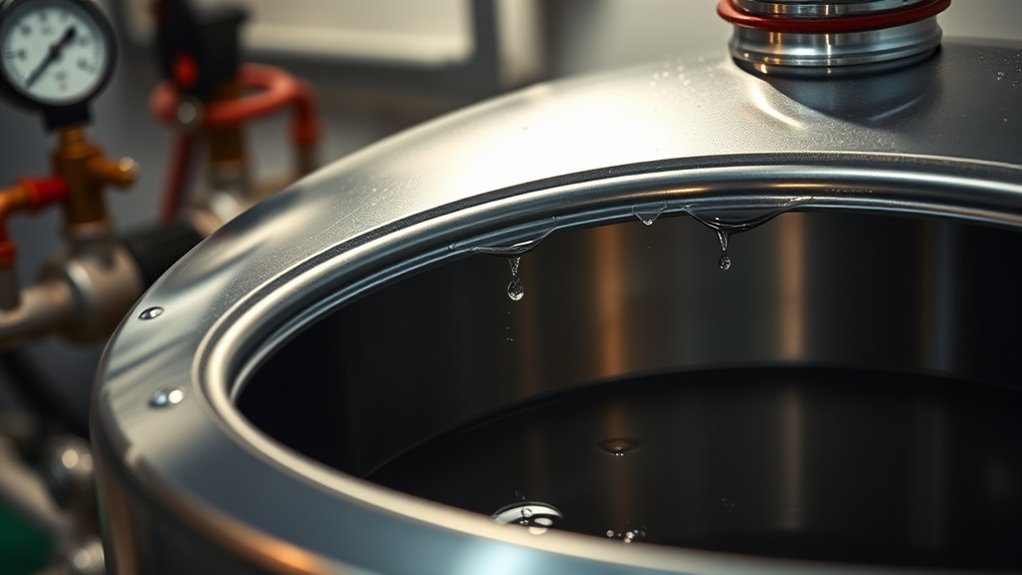
To effectively prevent splash-out during transient flow conditions, it’s important to incorporate adequate buffer space within the surge tank. This buffer acts as a cushion, allowing sudden changes in flow without spilling over. You should consider the maximum expected flow variations and allocate enough volume to accommodate these surges. Proper buffer space reduces pressure spikes and minimizes splash-out risks. Additionally, you can:
- Analyze flow fluctuation data to determine necessary buffer size
- Design the tank with a slightly larger capacity than the expected maximum volume
- Use flexible or adjustable baffles to absorb flow shocks
- Incorporate overflow outlets to safely vent excess volume
- Regularly monitor system performance and adjust buffer size as needed
- Consider total-cost clarity when planning your buffer size to ensure long-term affordability and efficiency.
These steps ensure your surge tank effectively manages transient conditions and prevents splash-out.
Evaluating Tank Placement and Connection Points

Choosing the most suitable location for your surge tank and its connection points is crucial for effective system performance. You want the tank positioned where it can quickly respond to pressure changes without causing flow disruptions. Typically, placing the tank near the pump or at a high point in the piping system helps absorb pressure surges efficiently. Make sure the connection points are accessible for maintenance and inspection. Proper placement minimizes pipe lengths and reduces pressure losses, improving response time. Also, avoid installing the tank in areas prone to vibrations or extreme temperatures, which could compromise its integrity. Remember, the goal is to create a direct, unobstructed flow path that allows the surge tank to perform its buffer function smoothly, preventing splash-out and system instability. Water parks often incorporate surge tanks or similar systems to manage water flow effectively and ensure safety during peak usage times.
Implementing Safety Margins and Redundancies

Incorporating safety margins and redundancies into your surge tank system guarantees reliable performance under varying conditions. You should design your system with buffer space to handle unexpected surges or fluctuations, preventing overflow or cavitation. Redundancies ensure continuous operation if one component fails, reducing downtime. Consider installing backup sensors or alarms to alert you of critical level changes. Use higher-rated valves and piping than the minimum requirements to accommodate future expansions or unexpected pressures. Regular maintenance and testing of safety devices help maintain system integrity. By implementing these measures, you reduce risks and improve overall stability, ensuring your system performs efficiently even during peak demands or unforeseen events. Proper planning now saves time and resources later, keeping your operation safe and dependable.
Frequently Asked Questions
How Does Temperature Variation Affect Surge Tank Sizing?
Temperature variation impacts surge tank sizing because it causes fluid expansion and contraction. When temperatures rise, the liquid volume increases, requiring a larger tank to accommodate the expansion. Conversely, lower temperatures reduce volume, but you still need enough space for thermal fluctuations. You should size your surge tank considering the maximum expected temperature changes, ensuring it can handle the full range of fluid volume without risking splash-out or system damage.
What Materials Are Best for Surge Tank Construction?
You should choose corrosion-resistant materials like stainless steel, polypropylene, or fiberglass for your surge tank. These materials withstand temperature fluctuations and chemical exposure, ensuring durability and safety. Stainless steel offers strength and longevity, while polypropylene and fiberglass provide excellent chemical resistance and cost-effectiveness. Selecting the right material depends on your specific fluid properties and operating conditions, but prioritizing corrosion resistance is key to maintaining tank integrity over time.
How to Retrofit an Existing System With a Surge Tank?
To retrofit an existing system with a surge tank, you should first identify the best location for installation, typically near the outlet or inlet. Then, shut down the system and connect the surge tank using appropriate piping and fittings. guarantee the tank is properly supported and integrated with your control systems. Finally, test the setup for leaks and proper operation before resuming normal operation.
What Maintenance Is Required for Surge Tanks?
Imagine your surge tank as a vigilant guardian, quietly working behind the scenes. You should regularly inspect it for corrosion, leaks, or buildup. Keep the vent and drain clear to guarantee smooth operation. Periodically clean the tank to prevent debris from causing blockages. Check the level sensors and valves for proper function. Staying attentive to these tasks keeps your system running smoothly, preventing costly breakdowns and ensuring safety.
How Do Surge Tanks Influence Overall System Efficiency?
Surge tanks improve your system’s efficiency by absorbing pressure fluctuations and preventing flow disruptions. They help maintain consistent fluid levels, reducing pump cycling and energy use. By balancing the system during sudden demand changes, surge tanks minimize wear and tear, extend equipment lifespan, and keep operations smooth. This results in less downtime and energy savings, ultimately enhancing overall system performance and reliability.
Conclusion
Now, picture your system as a delicate dance, with the surge tank acting as a steadying hand. By sizing it right, you prevent splash-out and keep the rhythm smooth. Think of it as creating a resilient safety net beneath a high-wire act—ready to catch sudden surges and fluctuations. With careful planning and precise calculations, you’ll guarantee your system flows seamlessly, avoiding chaos and keeping everything running like clockwork beneath a calm, confident surface.









